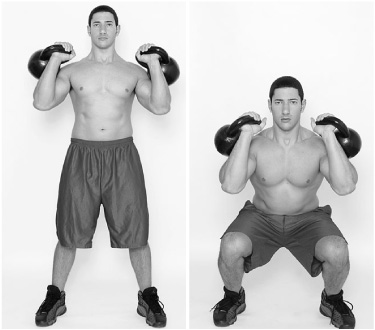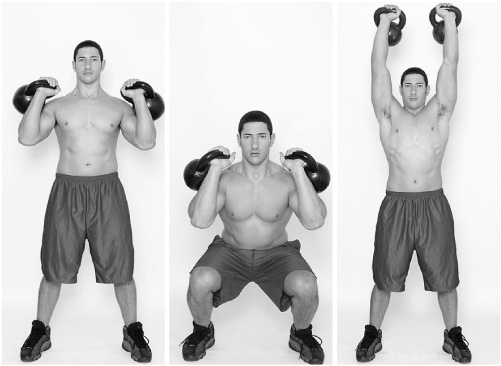
Week 6 consists of three huge combination movements: the double clean-squat, the double clean-squat-press, and the kettlebell push-up–row. Each of these is tough enough to be a stand-alone workout for an unconditioned athlete. Fortunately, you have been training for the last five weeks and are prepared for this. The chapter begins with the double clean-squat. This movement combines the power development of the double clean with the basic strength and leg development of the double squat. Each repetition consists of a clean and a squat. So yes, you have to clean the kettlebells every time. Be sure to keep your head up throughout this exercise. Poor posture becomes exacerbated as fatigue sets in, making it more difficult to complete each repetition. Conversely, an upright posture allows you to maximize your technique.
Upon the completion of the double clean-squat, your lower back will be fatigued but you will probably still have some energy left in your legs and definitely in your shoulders. This is a good time to start the double clean-squat-press. As you descend to the bottom position, think of yourself as a spring that is compressing. When you reach at least 90 degrees, explode upward and follow through into the press. The transition should be very smooth and powerful. You pause briefly when your arms are fully extended, to retain control, and then lower the kettlebells to your shoulders. Tip your elbows up to direct the kettlebells forward, and then explode back into your next clean. You will perform a clean, squat, and press with every repetition. This is a great exercise for any athlete who needs to jump or combine lower- and upper-body power, such as football and volleyball players.
The kettlebell push-up–row is the last exercise in this series. It is a brutal upper-body movement, but it gives your legs and lower back a needed break. You alternate between working your upper back and your chest. Take special care in selecting the kettlebells you use. It is necessary to have kettlebells with a base wide enough so they do not tip over when you are performing push-ups—usually weights of 50 pounds or greater. Ideally the kettlebells will be of the same weight. If they are not, just switch them after a set number of repetitions so that each side receives the same amount of work. You begin by placing your hands inside the kettlebells to perform your push-ups. I have found that the risk is not worth the reward when it comes to performing push-ups from the handles of the kettlebells. It is very likely that you will injure yourself when doing this—for little or no gain. Push-ups from the insides of the handles work just as well.
After you have performed your preset number of repetitions, remove one hand from inside the handle and grip the top of the same handle. Stabilizing with your weightless hand, row the kettlebell to your body. My preference for this exercise is to alternate between one row, one push-up, and then one row on the opposite side. I would count this group of movements as one repetition. When performed in this fashion, kettlebell push-up–rows challenge your cardiovascular system as well as your musculoskeletal system.
There are two other ways to perform the kettlebell push-up–row when the bases of your kettlebells are too small or you have only one kettlebell. The first is to keep one hand on the floor or on a block. You could work one side until that part of the set is finished or you could get up and switch sides every repetition or two. For example, one hand is inside the handle and you perform a push-up; then remove the hand and perform a row. Then get up, switch sides, and repeat. The other method of performing kettlebell push-up–rows is to perform all of your push-ups on the floor. You would be giving up a small portion of the range of motion but not so much as to lessen the value of this exercise. Simply row one kettlebell, remove your hand, perform a push-up, and then slide the kettlebell to the other side and perform a row. Any of these methods will work well so long as you give your full effort.
The double clean-squat combines two big movements. With all of the muscle that is put into play, your heart, legs, and back get a great workout. Each repetition consists of a full double clean and a full squat.
Set up as you usually would for a double clean. Keeping your head up, clean both kettlebells and pause briefly. Then bend your knees and hips, and squat as deeply as you are able (to spice up your workout, you can add a pause at the bottom of the squat). Extend your knees and hips, and stand up to a fully erect position. Tip your elbows up to direct the kettlebells forward. Then swing the kettlebells between your knees to begin the backswing for the next clean.
Double Clean-Squat Begin the double clean-squat in exactly the same way as you would the double clean. Once the kettlebells are shouldered, bend your knees and then your hips, and drop into the squat. The more your skill develops with this exercise, the faster you will be able to transition from the clean to the squat and back up again.
DOUBLE CLEAN-SQUAT: KEY POINTS
1. Set up for a double clean.
2. Clean both kettlebells to the racked position, and pause briefly.
3. Bend your knees and hips, and squat down to at least 90 degrees if able.
4. Explode out of the bottom position, and stand up straight.
5. Tip your elbows up to direct the kettlebells forward.
6. Allow the kettlebells to swing between your knees for a backswing.
7. Clean the kettlebells back up for the next repetition.
Perform the double clean-squat portion of this exercise the same as before. But instead of tipping the kettlebells forward after your rise out of the squat, follow through into the press. You want to use the momentum generated by your legs as you explode out of the bottom position and punch the kettlebells to a full extension overhead. After you fully extend your arms, pause briefly for control, and then lower the kettlebells back to your shoulders. Tip the kettles forward for the next clean. This is a great exercise for the whole body, and almost no muscle group is spared. It also winds you quickly and can be used as a conditioning exercise as well. Just increase your repetition scheme to a higher range for more of a cardiovascular workout.

Double Clean-Squat-Press Work this exercise in the same way as the double clean-squat. The addition of the press adds extra range of motion and therefore more work. Practice your transitions with this, and all, combination movements.
DOUBLE CLEAN-SQUAT-PRESS: KEY POINTS
1. Clean both kettlebells at the same time.
2. Pause briefly, and then squat as deeply as you are able.
3. Explode out of the bottom position to a fully erect stance.
4. The moment your knees are straight, punch the kettlebells overhead.
5. Pause briefly, and then lower the kettlebells to your shoulders.
6. Tip the kettlebells forward, and allow them to swing between your knees for the next clean.
Place two kettlebells of sufficient size on the floor, slightly wider than shoulder-width apart. Line the handles up in a straight line. Slide your hands through the handles with your palms down, and get into a push-up position. Execute a push-up as deeply as you are able. When your arms are fully extended, take one hand off of the bell and grip the handle. Row the kettlebell to your body until your hand touches your ribs. Lower the kettlebell, and then slide your hand back inside the handle. Execute another push-up; then proceed to row the opposite kettlebell. Continue to alternate rows on each side while performing a push-up between each one. This exercise works the chest, shoulders, triceps, biceps, and upper back, as well as the stabilizing muscles of the trunk.
Safety Note: You definitely want to use kettlebells with a wide base so that the weights do not tip over during this exercise. You can also use a modified version that involves performing the push-up off of the floor. One kettlebell would then be rowed while the other hand stayed on the floor. The push-up portion of this exercise can be performed from your knees or your toes depending upon your level of strength.
KETTLEBELL PUSH-UP–ROW: KEY POINTS
1. Place two kettlebells on the floor slightly wider than shoulder-width apart with the handles in a straight line.
2. Place your hands inside the handles with your palms down.
3. Perform a push-up; then remove one hand and grip the kettlebell handle.
4. Row the weight to your midsection, and then place the kettlebell back on the floor.
5. Put your hand back inside the handle, and perform another push-up.
6. Repeat the row on the opposite side; then perform another push-up.
7. Continue to alternate rows on each side, performing a push-up between each row.

Kettlebell Push-Up–Row Note that the model’s hand moves from inside of the handle for the push-up to outside of the handle for the row. Push-ups, as a general rule, should not be performed on top of the handles, because of the risk of tipping the kettlebells over.